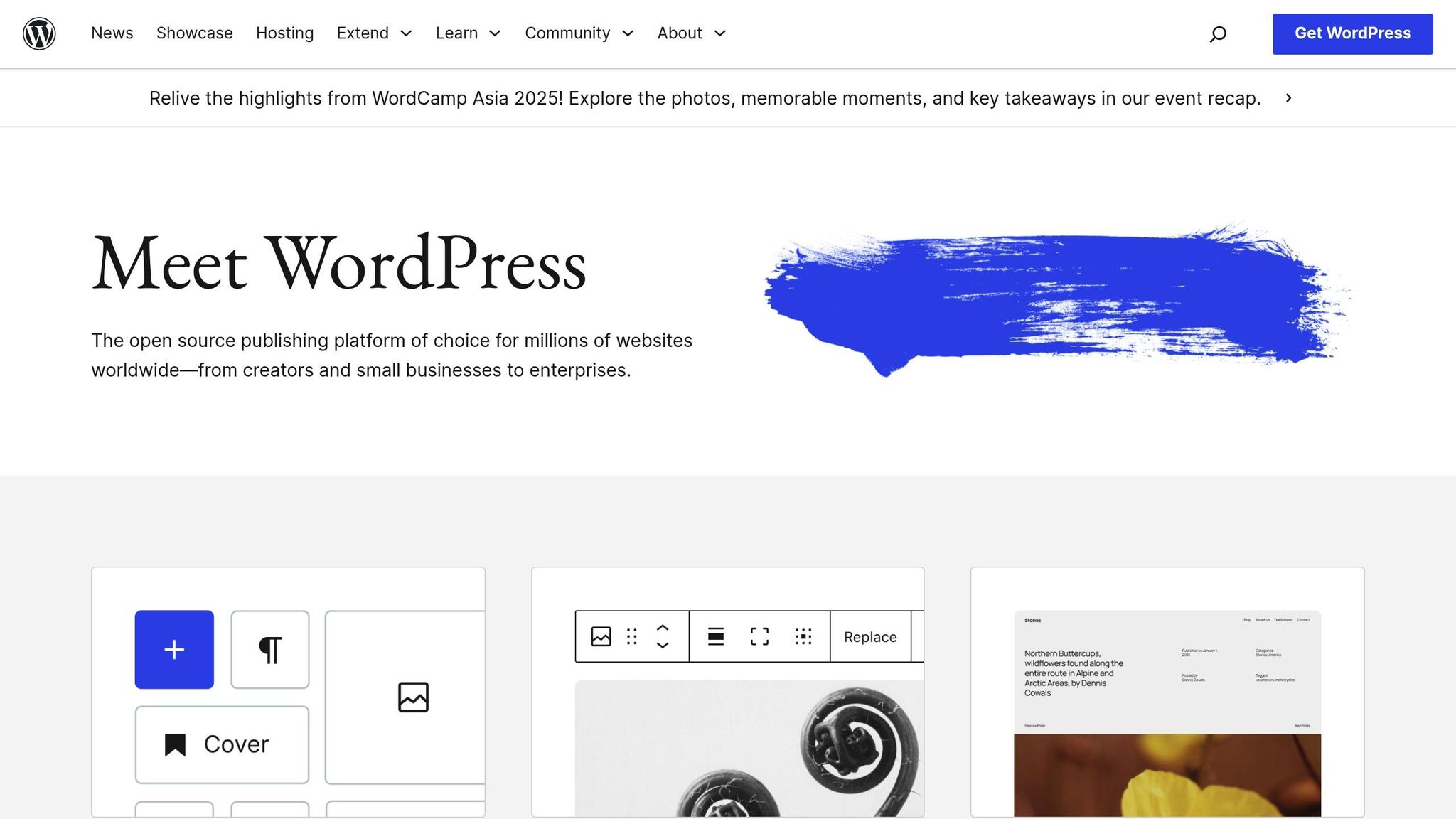Managing assignments in WordPress LMS platforms can be simple and effective. With the right tools, you can create, distribute, and evaluate assignments effortlessly while enhancing student engagement and tracking progress. Here’s a quick summary of what you need to know:
- Why Assignments Matter: They monitor progress, boost engagement, and evaluate skills.
- Key Features to Look For: File uploads, deadline controls, grading tools, and progress tracking.
- Steps to Get Started:
- Define assignment details (guidelines, formats, grading criteria).
- Adjust settings (file types, attempts, time limits).
- Embed assignments into courses strategically.
- Managing Submissions: Use automation for reminders, organize records, and streamline grading.
- Grading & Feedback: Combine manual and auto-grading, and provide actionable feedback.
Pro Tip: Choose an LMS plugin with robust assignment features to simplify your workflow and improve learning outcomes. Ready to dive in? Let’s explore the details.
Setting Up WordPress LMS Assignments

Choosing the Right LMS Plugin for Assignments
When setting up assignments in WordPress, the LMS plugin you choose can make or break the experience. Make sure it offers these must-have features:
- File Upload Options: Let students submit PDFs, documents, or multimedia files.
- Deadline Controls: Set and manage due dates easily.
- Grading Tools: Use built-in rubrics and scoring systems for evaluations.
- Progress Monitoring: Track submission statuses and completion rates.
- Feedback Features: Provide detailed comments and annotations directly.
Steps to Create Assignments
Once you’ve picked your plugin, here’s how to design effective assignments step by step:
1. Define Assignment Details
- Specify submission guidelines.
- Set word count or file size limits.
- List acceptable file formats.
- Develop clear grading criteria.
2. Adjust Assignment Settings
Tailor the technical setup to match your needs:
- Enable or restrict specific file types.
- Limit the number of submission attempts.
- Turn on auto-save for in-progress work.
- Add time limits if needed.
3. Set Up Grading Criteria
Plan how students’ work will be assessed:
- Build scoring rubrics for consistency.
- Configure point systems or pass/fail options.
- Enable peer review if applicable.
Integrating Assignments Into Courses
Once your assignments are ready, embed them into your course in ways that enhance learning. Placement matters – it should align with course goals and student progress.
Module Placement: Add assignments after relevant lessons to reinforce the material.
Progressive Challenge: Design assignments that gradually increase in complexity:
- Start with simple knowledge checks.
- Introduce tasks that apply learned concepts.
- End with comprehensive projects that tie everything together.
Balanced Distribution: Spread assignments across the course to keep engagement steady:
- Early assignments: Weight them at 15-20% of the total grade.
- Mid-course tasks: Assign 30-40% of the grade here.
- Final projects: Reserve 40-50% for these.
| Assignment Type | Recommended Placement | Purpose |
|---|---|---|
| Knowledge Checks | After each lesson | Assess understanding |
| Practice Exercises | Mid-module | Apply learned concepts |
| Major Projects | End of modules | Demonstrate mastery |
| Final Assessment | At course completion | Evaluate overall performance |
Tutor LMS | Assignment & Grading System Setup
Managing Student Submissions
Handling submissions is just as important as creating assignments. A well-structured system ensures smooth evaluation.
Student Upload Guidelines
Clear instructions help students submit assignments correctly. Use your WordPress LMS to set up specific requirements:
File Requirements
- Acceptable formats: PDF, DOCX, MP4
- Maximum file size: 10–25 MB
- Standardize file names (e.g., ASSIGN1_SMITH_J)
- Specify deadlines with time zones
Student Instructions
- Provide detailed upload steps
- Include screenshots for clarity
- Highlight common mistakes to avoid
- Explain how resubmissions work
| Submission Element | Requirement | Example |
|---|---|---|
| File Format | Accepted formats | PDF, DOCX, MP4 |
| File Size | Size limit | Max 25 MB |
| File Name | Standardized format | ASSIGN1_SMITH_J |
| Due Date | Time zone specific | Apr 15, 2025, 11:59 PM EST |
Once submissions start coming in, organize them for easy tracking and evaluation.
Organizing Submission Records
A structured approach to managing records makes handling submissions in your WordPress LMS more efficient.
Progress Tracking
- Log submission timestamps
- Monitor completion rates
- Identify students who need reminders
- Generate detailed progress reports
Automated Tools
Most WordPress LMS platforms offer automation to simplify the process:
- Send automatic reminder emails
- Integrate with CRM systems for better tracking
- Receive notifications for new submissions
- Automatically issue certificates upon completion
Team Collaboration
For courses with multiple instructors, assign roles to streamline responsibilities:
- Set distinct access levels for team leaders
- Delegate grading tasks to specific instructors
- Customize viewing permissions for assignments
- Enable collaborative feedback features
To maintain a smooth workflow:
- Review submissions daily
- Sort by due date for priority
- Flag incomplete or late submissions
- Keep records of all communications
- Archive completed assignments for future reference
sbb-itb-dee25d2
Grading and Feedback Methods
Once submissions are organized, the next step is evaluating student work effectively.
Manual and Auto-Grading Options
WordPress LMS platforms provide tools for both manual and automated grading. Use manual grading for assignments like essays or projects that require a personal touch, while auto-grading works well for structured tasks like multiple-choice quizzes. This combination allows for quick scoring on straightforward tasks and thoughtful evaluation where detailed feedback is needed.
Crafting Useful Feedback
Feedback should be clear and actionable. Highlight what students did well and point out specific areas for improvement tied to the learning goals. Offering practical suggestions helps students refine their skills and better prepare for future assignments.
Leveraging LMS Gradebooks
Built-in gradebooks make it easier to track student progress. They often include automatic grade calculations and visual tools to monitor performance over time. Keeping grade records updated regularly ensures transparency and helps students stay informed about their progress. These tools are key to maintaining an efficient and organized grading process in your WordPress LMS.
Assignment Management Tips
Managing assignments effectively in WordPress LMS can play a key role in helping students succeed.
Creating Clear Assignments
Start with a brief overview that explains the assignment’s purpose and learning goals. Break down complex tasks into smaller, easy-to-follow steps, using clear headings and visual aids.
When crafting instructions, focus on these important details:
| Element | Purpose | Example |
|---|---|---|
| Learning Objectives | Explain what students should accomplish | "By completing this assignment, you’ll demonstrate mastery of database normalization." |
| Time Requirements | Clarify how long it should take | "Estimated completion time: 2–3 hours." |
| Submission Format | Specify file types and naming rules | "Submit as PDF, filename: lastname_assignment1.pdf." |
| Evaluation Criteria | Detail grading components | "Technical accuracy (40%), Documentation (30%), Implementation (30%)." |
Gathering student input can help fine-tune these instructions for clarity and effectiveness.
Using Student Feedback
Adopt a structured approach to gather and use student feedback. This can include mid-assignment check-ins, post-submission surveys, and end-of-course reviews to identify challenges and adjust instructions.
Analyzing feedback trends can lead to meaningful improvements. For instance, if students frequently mention confusion about technical requirements, creating detailed submission guidelines or offering video tutorials could resolve those issues.
Conclusion
Managing assignments in WordPress LMS requires clear guidelines, effective tools, and prompt feedback. Success hinges on choosing LMS plugins that provide robust assignment features while remaining easy to use for both educators and students. These steps help create a more efficient and engaging learning platform.
Well-structured assignments play a big role in keeping students engaged and driving their success. By focusing on reliable implementation techniques, course creators can significantly improve their learning environments.
Next Steps
Take your platform to the next level with these steps:
-
Upgrade Your Platform
Invest in professional design and support to align your platform with top LMS plugins. This ensures smoother assignment management. Pro Membership Sites offers WordPress-based solutions that integrate seamlessly with popular LMS tools. -
Add Key Features
Feature Purpose Priority Progress Tracking Tracks student progress High Automated Communications Sends assignment reminders Medium Certificate Management Awards completion certificates Medium Quiz Integration Evaluates student understanding High -
Optimize Your System
Set up membership levels and tailored learning paths. Include automated notifications, grade tracking systems, and clear assessment standards to streamline the process.
Pro Membership Sites simplifies assignment management by offering user-friendly websites packed with built-in learning tools and customization options. Their solutions focus on making life easier for educators while helping students succeed, creating a more effective learning experience.





